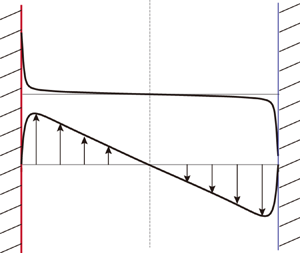Article contents
Mean velocity and temperature profiles in turbulent vertical convection
Published online by Cambridge University Press: 22 December 2023
Abstract

In this study, mean velocity and temperature profiles for turbulent vertical convection (VC) confined in an infinite channel are investigated theoretically. The analysis starts from the governing equations of the thermal flow, with Reynolds shear stress and turbulent heat flux closed by the mixing length theory. Employing a three-sublayer description of the mean fields, the mean velocity and temperature profiles are found to be linear laws near the channel wall (viscosity-dominated sublayer), and they follow power laws close to the channel centre (turbulence-dominated sublayer). The characteristic scales of velocity, temperature and length in the present profiles arise naturally from the system normalisation, rather than from scaling analyses, thus ensuring a sound mathematical description. The derived profiles are verified fully via various literature data available in the classical regime; further, they are compared with the reported profiles, and the results indicate that the present profiles are the only ones with the ability to interpret data accurately from different sources, demonstrating much better versatility. Meanwhile, we provide analytical arguments showing that in the ultimate regime, the mean profiles in VC may remain in power laws, rather than the log laws inferred by analogy with Rayleigh–Bénard convection (RBC) systems. The power profiles recognised in this study are induced by the effect of buoyancy, which is in parallel with the mean flow in VC and contributes to the streamwise momentum transport, whereas in RBC systems, buoyancy is perpendicular to the mean flow, and does not influence the streamwise momentum transport, resulting in log profiles, being similar to the case of wall shear flows.
JFM classification
- Type
- JFM Papers
- Information
- Copyright
- © The Author(s), 2023. Published by Cambridge University Press
References
- 3
- Cited by



